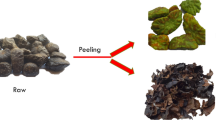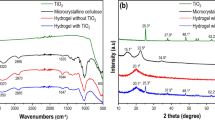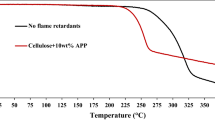Abstract
Cellulose derived from cotton was ball-milled with some hydrophilic and hydrophobic solvents such as water, toluene, 1-butanol and also without solvent (dry state), and effect of the solvents on morphological and structural changes of the cellulose were investigated. The original fibrous cellulose was changed to the aggregated globular particles by water and dry state ball-milling, plate-like particles by toluene processing, and a mixture of rugged globular particles and plate-like particles by 1-butanol processing. The globular particles prepared without solvent showed fairly low crystallinity and their inter- and intra-molecular hydrogen bonds were deformed, leading to an increase in free hydroxyl groups. The globular particles prepared with water exhibited a mixture of crystalline structure as cellulose I, cellulose II and non-crystalline state. In the case of the products with toluene, the plate-like particles significantly retained their original crystalline structure and hydrogen bonds. The 1-butanol processing seems to give the particles consisting of cellulose I and small amounts of either non-crystalline or cellulose II. The cellulose/dye stuff mixtures under the presence of the above solvents were prepared using 4-aminoazobenzene to investigate the differences in the surface property of the particles prepared by the ball-milling processing. Characteristic color development of each cellulose particles was clearly distinguished depending on the effect of the solvent (cinnabar; without solvent, yellow; toluene and yellowish-green; water or 1-butanol).
Similar content being viewed by others
Log in or create a free account to read this content
Gain free access to this article, as well as selected content from this journal and more on nature.com
or
References
For example, C. Yamane and K. Okajima, Sen-i Gakkaishi, 53, 321 (1997).
M. Ago, T. Endo, and T. Hirotsu, Cellulose, 11, 163 (2004).
H. Ono, M. Inamoto, and K. Okajima, Cellulose, 4, 57 (1997).
G. N. Marchenko, V. N. Marsheva, V. I. Kovalenko, Ye. M. Belova, G. M. Khrapovskii, N. G. Gustova, and V. F. Sopin, Polym. Sci. USSR, 25, 1647 (1983).
K. Sato, H. Mochizuki, K. Okajima, and C. Yamane, Polym. J., 36, 478 (2004).
C. Yamane, T. Aoyagi, M. Ago, K. Sato, K. Okajima, and T. Takahashi, Polym. J., 38, 819 (2006).
T. Hori and H. Zollinger, Text. Chem. Color., 18, 19 (1986).
S. Woodcock, B. Henrissat, and J. Sugiyama, Biopolymers, 36, 201 (1995).
M. K. Inglesby, Ph.D.Dissertation, University of California, Davis, 2000.
A. Isogai and M. Usada, Sen-i Gakkaishi, 46, 324 (1990).
A. Isogai, M. Usada, T. Kato, T. Uryu, and R. H. Atalla, Macromolecules, 22, 3168 (1989).
A. J. Stamm, “Wood and Cellulose Science,” Ronald Press, New York, 1964, Chapter 7 and 8.
J. Nakano, T. Higuchi, M. Sumimoto, and A. Ishidu, “Mokuzai-Kagaku,” Uni Publishers, Tokyo, 1985, Chapter 2.
S. P. Rowland, ACS Symposium Series No. 49, 1977, Chapter 2.
Jpn.-open patent 2004-230719.
M. Sasahira, C. Yamane, and K. Okajima, Cell. Commun., 10, 2 (2003).
C. Yamane, M. Mori, M. Saito, and K. Okajima, Polym. J., 28, 1039 (1996).
“Cellulose and Cellulose Derivatives,” E. Otto Ed., Interscience Publishers, Inc, 1954, Vol. IV chapter XIII.
C. Y. Liang and R. H. Marchessult, J. Polym. Sci., 37, 385 (1959).
N. V. Ivanova, E. A. Korolenko, E. V. Korolik, and R. G. Abankov, Zh. Prikl. Spektrosk., 51, 301 (1989).
D. Fengel, Holzforschung, 47, 103 (1993).
Y. Maréchal and H. Chanzy, J. Mol. Struct., 523, 183 (2000).
Y. Maréchal, J. Chem. Phys., 87, 6344 (1987).
K. Bredereck, W. A. Schick, and E. Bader, Makromol. Chem., 186, 1643 (1985).
M. Ago, K. Sato, and K. Okajima, Cellulose Commun., 12, 58 (2005).
S. Manabe, M. Iwata, and K. Kamide, Polym. J., 18, 1 (1986).
Author information
Authors and Affiliations
Corresponding author
Rights and permissions
About this article
Cite this article
Ago, M., Endo, T. & Okajima, K. Effect of Solvent on Morphological and Structural Change of Cellulose under Ball-Milling. Polym J 39, 435–441 (2007). https://doi.org/10.1295/polymj.PJ2006096
Received:
Accepted:
Published:
Issue date:
DOI: https://doi.org/10.1295/polymj.PJ2006096
Keywords
This article is cited by
-
Intensification of low concentration alkaline pretreatment with planetary ball milling for efficient enzymatic saccharification of enset fiber (Ensete ventricosum)
Biomass Conversion and Biorefinery (2023)
-
Green approach for the activation and functionalization of jute fibers through ball milling
Cellulose (2020)
-
Cellulose nanosheets formed by mild additive-free ball milling
Cellulose (2019)
-
Mechanochemistry of cellulose
Cellulose (2019)
-
Novel Isolation of Empty Fruit Bunch Lignocellulose Nanofibers Using Different Vibration Milling Times-Assisted Multimechanical Stages
Waste and Biomass Valorization (2017)



